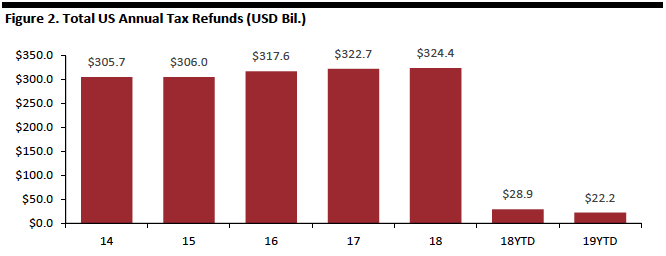albert Chan
Each year, the U.S. Internal Revenue Service (IRS) reports tax return filings and refunds on a weekly basis, starting in February and going into the April 15 filing deadline. It is still early in the filing season, so there will likely be more variability to the data. Filings are likely delayed due to confusion over the new tax rates and the government shutdown, which made it difficult for accountants to get answers to help people prepare income tax returns. After the second week of returns data, the year-over-year decline in the number of filing has moderated, indicating that tax filings are catching up.
As of February 8, 2019:
 Source: IRS[/caption]
The graph below shows total annual refunds disbursed to consumers, which increased at a 1.5% CAGR during 2014–2018.
Given a solid U.S. economy, higher wages and employment rates, total refunds are likely to be higher in 2019, once the disruption from the government shutdown is resolved. Still, a recent report from the National Taxpayer Advocate stated that the week the shutdown ended, the wait time to speak with an IRS representative had grown to 17 minutes, up from four minutes last year, and only 48% of callers were able to reach a live representative, down from 86%, last year, inflicting “real harm on taxpayers.”
[caption id="attachment_76829" align="aligncenter" width="666"]
Source: IRS[/caption]
The graph below shows total annual refunds disbursed to consumers, which increased at a 1.5% CAGR during 2014–2018.
Given a solid U.S. economy, higher wages and employment rates, total refunds are likely to be higher in 2019, once the disruption from the government shutdown is resolved. Still, a recent report from the National Taxpayer Advocate stated that the week the shutdown ended, the wait time to speak with an IRS representative had grown to 17 minutes, up from four minutes last year, and only 48% of callers were able to reach a live representative, down from 86%, last year, inflicting “real harm on taxpayers.”
[caption id="attachment_76829" align="aligncenter" width="666"] Source: IRS[/caption]
Source: IRS[/caption]
- The IRS had received 28.8 million tax returns and processed 27.0 million of them. The number of returns processed was down 10.2% from the corresponding date a year ago.
- Of the returns filed, 96.0% were electronically filed. Of those, 39.9% were prepared by tax professionals, the remaining 60.1% self-prepared.
- Fewer people are using the IRS website to get information: the site logged about 106.4 million visits, down 6.9% from the year-ago period.
- A total of 11.4 million refunds had been issued as of February 8, totaling $21.2 billion and averaging $1,949 each. The number of refunds issued was down 15.8% and the total amount refunded was down 23.2% year-over-year, and the average refund is down 8.7%.
- Of those refunds issued, 94.8% were paid using direct deposit. The average direct deposit refund was $1,996, down 9.2% from the corresponding date last year.
 Source: IRS[/caption]
The graph below shows total annual refunds disbursed to consumers, which increased at a 1.5% CAGR during 2014–2018.
Given a solid U.S. economy, higher wages and employment rates, total refunds are likely to be higher in 2019, once the disruption from the government shutdown is resolved. Still, a recent report from the National Taxpayer Advocate stated that the week the shutdown ended, the wait time to speak with an IRS representative had grown to 17 minutes, up from four minutes last year, and only 48% of callers were able to reach a live representative, down from 86%, last year, inflicting “real harm on taxpayers.”
[caption id="attachment_76829" align="aligncenter" width="666"]
Source: IRS[/caption]
The graph below shows total annual refunds disbursed to consumers, which increased at a 1.5% CAGR during 2014–2018.
Given a solid U.S. economy, higher wages and employment rates, total refunds are likely to be higher in 2019, once the disruption from the government shutdown is resolved. Still, a recent report from the National Taxpayer Advocate stated that the week the shutdown ended, the wait time to speak with an IRS representative had grown to 17 minutes, up from four minutes last year, and only 48% of callers were able to reach a live representative, down from 86%, last year, inflicting “real harm on taxpayers.”
[caption id="attachment_76829" align="aligncenter" width="666"] Source: IRS[/caption]
Source: IRS[/caption]